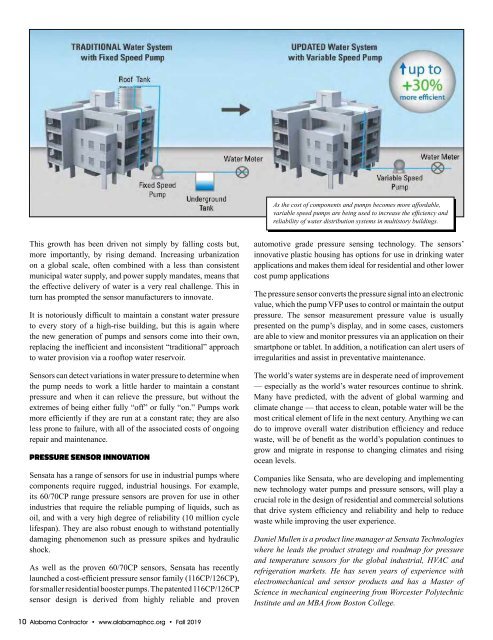Alabama Contractor Fall 2019
You also want an ePaper? Increase the reach of your titles
YUMPU automatically turns print PDFs into web optimized ePapers that Google loves.
As the cost of components and pumps becomes more affordable,<br />
variable speed pumps are being used to increase the efficiency and<br />
reliability of water distribution systems in multistory buildings.<br />
This growth has been driven not simply by falling costs but,<br />
more importantly, by rising demand. Increasing urbanization<br />
on a global scale, often combined with a less than consistent<br />
municipal water supply, and power supply mandates, means that<br />
the effective delivery of water is a very real challenge. This in<br />
turn has prompted the sensor manufacturers to innovate.<br />
It is notoriously difficult to maintain a constant water pressure<br />
to every story of a high-rise building, but this is again where<br />
the new generation of pumps and sensors come into their own,<br />
replacing the inefficient and inconsistent “traditional” approach<br />
to water provision via a rooftop water reservoir.<br />
Sensors can detect variations in water pressure to determine when<br />
the pump needs to work a little harder to maintain a constant<br />
pressure and when it can relieve the pressure, but without the<br />
extremes of being either fully “off” or fully “on.” Pumps work<br />
more efficiently if they are run at a constant rate; they are also<br />
less prone to failure, with all of the associated costs of ongoing<br />
repair and maintenance.<br />
PRESSURE SENSOR INNOVATION<br />
Sensata has a range of sensors for use in industrial pumps where<br />
components require rugged, industrial housings. For example,<br />
its 60/70CP range pressure sensors are proven for use in other<br />
industries that require the reliable pumping of liquids, such as<br />
oil, and with a very high degree of reliability (10 million cycle<br />
lifespan). They are also robust enough to withstand potentially<br />
damaging phenomenon such as pressure spikes and hydraulic<br />
shock.<br />
As well as the proven 60/70CP sensors, Sensata has recently<br />
launched a cost-efficient pressure sensor family (116CP/126CP),<br />
for smaller residential booster pumps. The patented 116CP/126CP<br />
sensor design is derived from highly reliable and proven<br />
automotive grade pressure sensing technology. The sensors’<br />
innovative plastic housing has options for use in drinking water<br />
applications and makes them ideal for residential and other lower<br />
cost pump applications<br />
The pressure sensor converts the pressure signal into an electronic<br />
value, which the pump VFP uses to control or maintain the output<br />
pressure. The sensor measurement pressure value is usually<br />
presented on the pump’s display, and in some cases, customers<br />
are able to view and monitor pressures via an application on their<br />
smartphone or tablet. In addition, a notification can alert users of<br />
irregularities and assist in preventative maintenance.<br />
The world’s water systems are in desperate need of improvement<br />
— especially as the world’s water resources continue to shrink.<br />
Many have predicted, with the advent of global warming and<br />
climate change — that access to clean, potable water will be the<br />
most critical element of life in the next century. Anything we can<br />
do to improve overall water distribution efficiency and reduce<br />
waste, will be of benefit as the world’s population continues to<br />
grow and migrate in response to changing climates and rising<br />
ocean levels.<br />
Companies like Sensata, who are developing and implementing<br />
new technology water pumps and pressure sensors, will play a<br />
crucial role in the design of residential and commercial solutions<br />
that drive system efficiency and reliability and help to reduce<br />
waste while improving the user experience.<br />
Daniel Mullen is a product line manager at Sensata Technologies<br />
where he leads the product strategy and roadmap for pressure<br />
and temperature sensors for the global industrial, HVAC and<br />
refrigeration markets. He has seven years of experience with<br />
electromechanical and sensor products and has a Master of<br />
Science in mechanical engineering from Worcester Polytechnic<br />
Institute and an MBA from Boston College.<br />
10 <strong>Alabama</strong> <strong>Contractor</strong> • www.alabamaphcc.org • <strong>Fall</strong> <strong>2019</strong>


















